Town Story: Castle Rock
Subscribe Now!Cornerstone of the Front Range
Cornerstone of the Front Range
If famed explorer John C. Fremont had his way, the city of Castle Rock might well be named Flapjack.
Fremont must have been hungry when he passed through Colorado in 1843, because he wrote that the peculiar, pale pink formation in central Colorado’s Front Range looked like a “Poundcake Rock.”
Fortunately for the citizens of this growing community, gold seeker David Kellogg climbed to the top of the rock with his buddies 15 years later, fired his gun into the distance and christened the place “Castle Rock.”
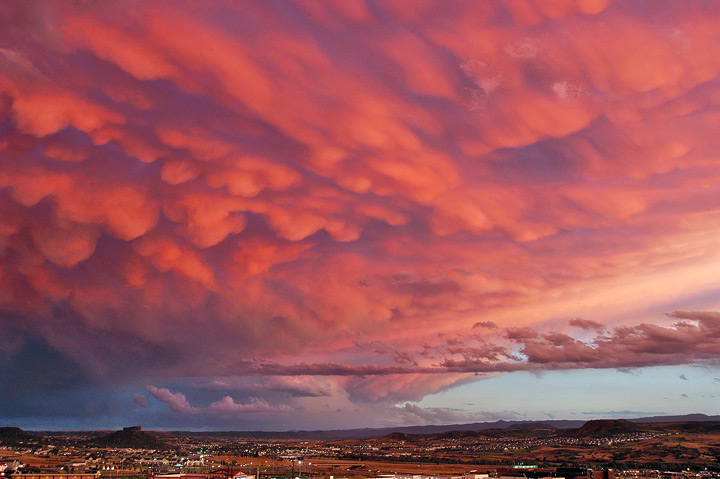
Prospectors like Kellogg didn’t find gold under Castle Rock or in the other buttes rising above Plum Creek, but the land instead was filled with rhyolite, a stone that would provide the building blocks for a community of quarry workers, ranchers, railroaders and commuting tech entrepreneurs.
Located nearly halfway between Denver and Colorado Springs, the famed rock still beckons Interstate 25 travelers to fill their tanks at gas stations, their shopping bags at outlet stores and their stomachs at downtown cafes, which fittingly serve mountainous and delicious flapjacks in the city of Castle Rock.
One of those cafes is the B&B, a place of modern and historic significance to the city.
Customers line up at 6 a.m. every day along the original marble bar for coffee and ample stacks of syrupy buttermilk pancakes. The landmark closed for six months but opened recently under the ownership and stewardship of Robert Schoene and Chris Gill.
“We wanted to give the B&B back to Castle Rock,” Gill said, “and the town embraced us.”
In return, Schoene and Gill have embraced Castle Rock. Usually only open for breakfast and lunch, the B&B opened for two nights with a special supper menu and asked customers to pay whatever they wanted, with all proceeds going to buy hearing aids for 11-month-old Jenimae Michener, who was born with 90-percent hearing loss.
While a friendly cornerstone of the community nowadays, the B&B is the site of perhaps Castle Rock’s greatest tragedy.
On Valentine’s Day 1946, 17-year-old Manuel Perez, a fugitive wanted for shooting two Denver police officers, was lying low in Castle Rock along the brushy banks of Plum Creek. After days on the lam, his hunger got the best of him. Thinking he wouldn’t be recognized, Perez entered the B&B for lunch.
The restaurant’s loyal patrons remembered Perez’ face from newspaper photographs and called Castle Rock Town Marshal Raymond Lewis, who lived only a block and a half away. Lewis arrived at the cafe unarmed, approached Perez and ordered him to put his hands in the air.
Instead, Perez quickly turned on the marshal, pulled a revolver from his coat and fatally shot Lewis twice.
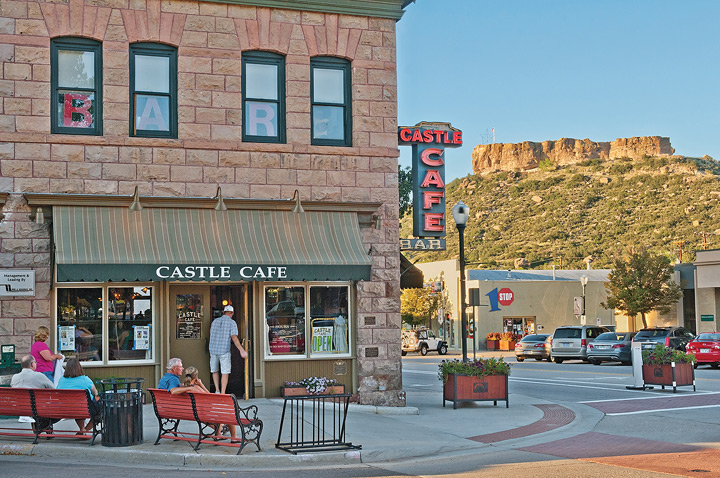
Defending themselves with weapons including a flowerpot and a hunting knife, cafe customers jumped on Perez. Shots went off. One of the customers was shot in the hand while Perez suffered a grazing shot to the ear. Patrons eventually subdued Perez until a Douglas County undersheriff arrived to make the arrest and calm down the angry citizens, who were ready to hang Perez from a tree across the street.
A bullet hole still can be seen near a ceiling fan in the middle of the B&B. Another hole is surrounded by shattered marble behind the bar.
“It was like an Old West story. The only difference is the good guy got shot,” said Lowell Bush, who owns the building and operated a barbershop next to the cafe.
He shared the story countless times while cutting the hair of cowboys, who exchanged with him with stories of their own exploits across the street at Castle Cafe, which is famous for its rough-and-tumble history and its made-from-scratch, pan-fried chicken.
Brawls were so common there that the county hired an extra deputy to patrol on paydays to restrain inebriated cowboys from riding their horses through the bar. Built with native rhyolite, Castle Cafe has been a hotel, big-band-era dance floor and even a saddlery. General Manager Dave Doty says employees sometimes hear the ghostly sound of cowboy boots scooting along the floor late at night.
Just to the south is a Douglas County government building that looks oddly out of place from the cafes on the opposite corners. A stately courthouse built of rhyolite at the site burned in 1978 at the hand of another troubled 17-year-old, who started a small gasoline fire in a basement stairwell. The blaze quickly exploded out of control. The courthouse fire was so hot it ignited oxygen in the rhyolite stones, causing them to shoot through the air like bombs. In the aftermath, residents found courthouse stones strewn across downtown. Because of this, the cafe’s owners don’t hesitate to call the fire department when they suspect there may be a fire in their building.
Even if the beloved rhyolite courthouse no longer stands, examples of master stonework still exist among historic homes lining Castle Rock’s Cantril and Lewis streets, as well as the Denver & Rio Grande Railroad depot – now home to the Castle Rock Museum. Here, visitors can see signatures of railroad employees who scrawled on its rock walls as long ago as 1875. Castle Rock has supplied stones for numerous architectural wonders elsewhere including Denver’s Molly Brown House and Trinity United Methodist Church.
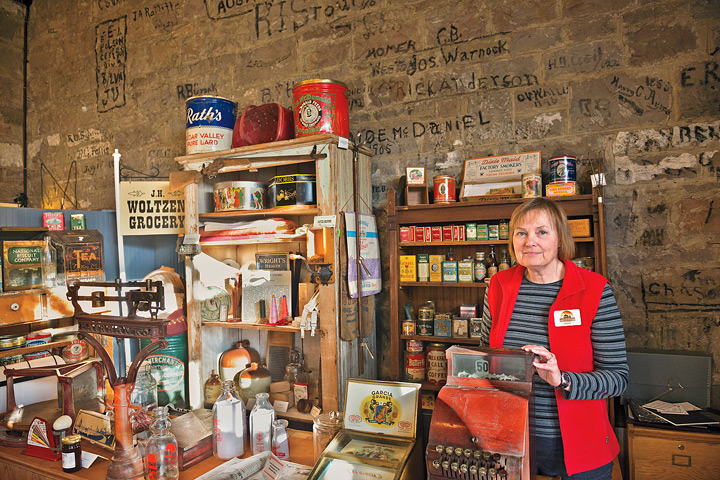
Castle Rock’s trademark rhyolite is so rare and beautiful because it is the result of a singular volcanic event. About 36.7 million years ago a glowing avalanche of incandescent pumice fragments erupted from the Mount Princeton area near modern-day Buena Vista. The cloud of 1,600-degree ash traveled nearly 100 miles in one hour before descending on a rainforest where Castle Rock now stands. The high-temperature ashfall quickly cooled into a rock that is surprisingly as sturdy as granite yet weighs up to 40 percent less and can be cut by simple hammers and chisels.
Today, Schmidt Aggregates is the only supplier of Castle Rock rhyolite, producing road base and decorative stone storefronts for clients like Walmart and Wendy’s. While keeping an eye out for herds of pronghorn and rattlesnakes that sunbathe on the access road, Don Opheim, manager of Schmidt’s Mencenberg Quarry, guides visitors who tour this picturesque prairie plateau east of town,
“This is a lost art,” Opheim said while examining a rock wall striped in a rainbow of tan, purple and pink waiting to be extracted for decorative boulders or veneer accents.
The rhyolite quarries employed hundreds of people a century ago, though due to a mix of technological advances requiring fewer workers and a shift in contractors’ taste away from rhyolite, the workforce at Mencenberg is fewer than 10.
Near the location of Castle Rock’s first quarry, the town attracted attention in the 1960s as a motorsports mecca. Continental Divide Raceway had everything a fan with a need for speed wanted, including a 2.8-mile road course, a half-mile oval, a drag strip and cameos by famous drivers. Mario Andretti, A.J. Foyt, Evel Knievel and Dick Smothers of the comedic duo The Smothers Brothers all raced there and were spotted celebrating at the Castle Cafe afterward.
The raceway’s most thrilling event was the 1960 U.S. Auto Club Road Racing Championship, featuring a showdown between Jim Hall in an Italian-built Birdcage Maserati and Carroll Shelby in a Scarab, a custom car from the United States with a Chevrolet engine. Shelby’s mechanic reportedly assured him: “This sumbitch will run – I’ve added 40 horsepower to it.”
Hall had the raceway’s lap record, but Shelby beat it by four seconds while comfortably dressed in overalls from his chicken farm. Shelby later said his win at Castle Rock inspired him to follow a dream to build his own high-powered American sports car, the Cobra, now renowned as one the best-designed muscle cars of all time.
The raceway closed in 1979 after an accident killed a driver and a person in a pit lane. New owners bought the land for an as-yet-undeveloped housing project and plowed over the tracks to prevent the location from being used as a raceway. Sharp-eyed motorists on the interstate may see a hill where the grandstands used to be southwest of Castle Rock.
In the absence of the raceway, John Manka, owner of downtown repair shop 1 Stop Auto, keeps Castle Rock’s enthusiasm for automobiles alive by organizing the yearly Classic Rock Cruise In Car Show on Father’s Day weekend. A Friday-night concert attracts thousands of revelers, and more than 300 owners show their vintage cars Saturday.
“There’s buy-in from the whole town,” Manka said. “The fire chief picks the hottest car; the police chief picks the car most likely to be pulled over. Everyone has a great time.”
Manka’s love of cars is just one result of the engineering skills that took him from his native Canada to Castle Rock. He partnered in a startup cable company eventually known as Wide Open West which moved from Castle Rock to the nearby Denver Tech Center. Manka decided to sell his stake in the cable business and stay put, becoming vice president of the Castle Rock Downtown Merchants Association before he even had a green card.
“Castle Rock has mobile homes to mansions, but there are no cliques here. It’s such an approachable town, not closed to outsiders,” he said.
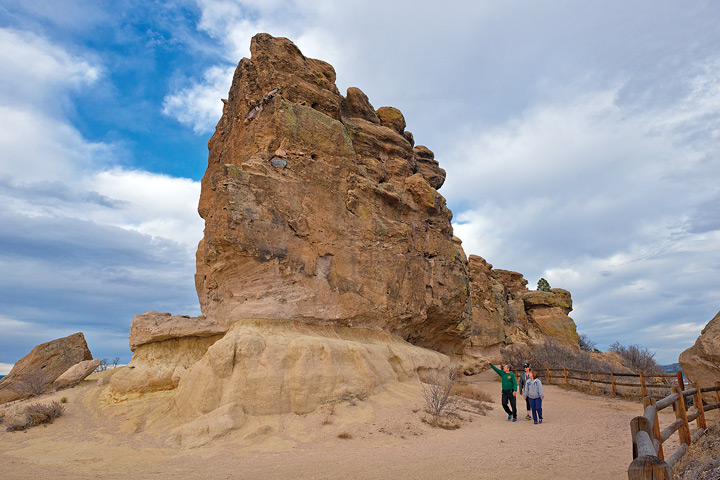
Castle Rock has grown at nearly the speed of a Shelby sports car. In 1994, its population hit the milestone of 10,000 residents. Today? Castle Rock has eclipsed 50,000.
The growth has been fueled in part by lucrative jobs in the technology, aerospace and telecommunications industries. Residents commute to the Tech Center and Colorado Springs military installations, among others.
Frank Gray, president of the Castle Rock Economic Development Council, hopes more tech firms will decide to locate within town limits and perhaps give it a new nickname: “Silicon Rock.” He is encouraged that the 50,000-square-foot office project known as the Move, which breaks ground this spring, already is more than 85 percent leased to tech companies.
The project is expected to attract firms with young workers who will appreciate the downtown coffee shops, restaurants like the B&B and Castle Cafe, outdoor film festivals, pub tours and events like the popular holiday star-lighting at the top of the rock, all within walking distance.
Yet, even with this growth, locals say Castle Rock has been able to maintain its small-town identity.
“Places in Castle Rock have a ‘Cheers’ vibe,” said Desiree LaFleur, who owns the eclectic downtown gallery Finn LaFleur with her husband, Billy, and brother Carlos Michael Finn.
When he’s not helping at the gallery, Billy works at Castle Rock’s Red Hawk Ridge Golf Course, one of three premier courses in the area including Plum Creek and Castle Pines. He calls the mountainous course the best office on the planet, “like working at a playground.”
Golf courses and more than 5,000 acres of town parks and open spaces are reasons why the LaFleurs can’t imagine living anywhere else. They donated two large Adirondack chairs as rest stops for runners who reach the summit of the Challenge Staircase, a 200-step incline leading to the top of a butte above the newly opened Philip S. Miller Park. The park also boasts a field house equipped with artificial-turf football fields, a pool and a trampoline play area.
Castle Rock has spread to encompass 34 square miles within the last five years, but residents have little fear that it will lose its small-town charm, because it is grounded in ranching values.
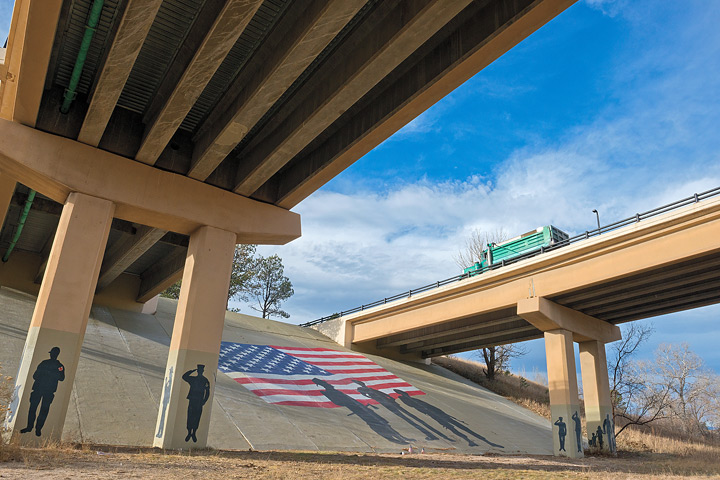
“Castle Rock was just a truck stop,” said Arlene Weimer, a descendent of the pioneering Curtis family. After a 1965 flood devastated roads and bridges, ranchers came into town not only to relax at the Castle Cafe but to help rebuild. Since then, residents gained a new respect for each other regardless of whether they were from the rural or urban sides of town.
Weimer, who served as executive secretary for four principals at Douglas County High School, points to other sources of pride, like the success of the school’s graduate actress Amy Adams as evidence of how Castle Rock is an ideal place to raise a family.
Even though her family sold their Douglas County ranch in the 1980s, Brooke Fox, president of Colorado Agricultural Leadership Foundation, found a place where her hands-on education in ranching came in handy. CALF hosts field trips and camps for city children to experience country life at the ranch of John and Bea Lowell just south of Castle Rock.
Activities that range from planting and harvesting corn to churning butter teach students where food comes from. Lowell Ranch also allows children who live in Castle Rock’s subdivisions to learn how to take care of their own livestock boarded at the ranch. Some of these children work on 4-H and FFA projects and go on to study agriculture in college.
“This is a place where kids can be kids: caring for animals, playing in Plum Creek, climbing trees,” Fox said. “The ranch is so close to people who feel they can’t get away from the daily grind, but it’s right in their backyard.”
From the southern ranches to downtown to the northern neighborhoods of The Meadows, Castle Rock’s namesake always is in sight. Residents, new and old, still flock to Rock Park for a chance to climb to the same spot where the prospector Kellogg crowned a new town more than 150 years ago. From the top, it’s easy to feel like a monarch surveying a panoramic view of a kingdom stretching from snow-capped Pikes Peak to Longs Peak, and the thriving Front Range in between.
From below, Lowell Bush watches the climbers through binoculars from his office window next to the B&B Cafe.
“I love looking at that rock,” he said. “I make sure to look at it every day.”
Subscribe to Colorado Life Magazine and receive thoughtful stories and beautiful photography featuring travel, history, food, nature and communities of Colorado.
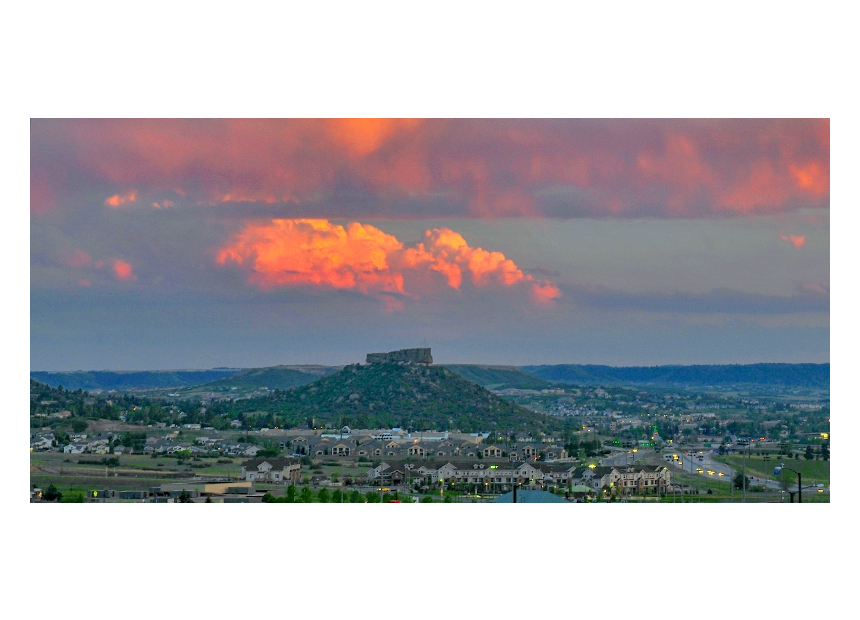
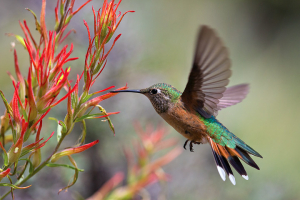
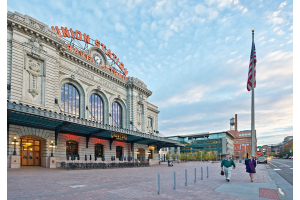
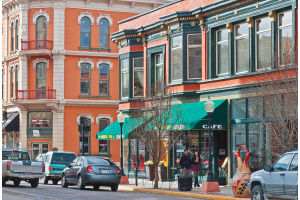
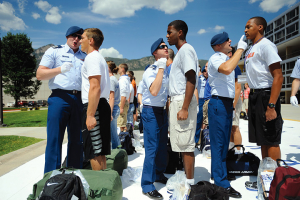
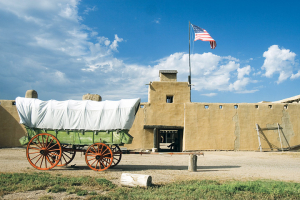
The information below is required for social login
Sign In
Create New Account